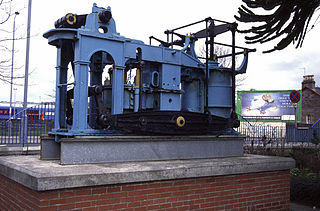
A steamship, often referred to as a steamer, is a type of steam-powered vessel, typically ocean-faring and seaworthy, that is propelled by one or more steam engines that typically move (turn) propellers or paddlewheels. The first steamships came into practical usage during the early 1800s; however, there were exceptions that came before. Steamships usually use the prefix designations of "PS" for paddle steamer or "SS" for screw steamer. As paddle steamers became less common, "SS" is assumed by many to stand for "steamship". Ships powered by internal combustion engines use a prefix such as "MV" for motor vessel, so it is not correct to use "SS" for most modern vessels.

The Thames Ironworks and Shipbuilding Company, Limited was a shipyard and iron works straddling the mouth of Bow Creek at its confluence with the River Thames, at Leamouth Wharf on the west side and at Canning Town on the east side. Its main activity was shipbuilding, but it also diversified into civil engineering, marine engines, cranes, electrical engineering and motor cars.
Earle's Shipbuilding was an engineering company that was based in Hull, East Riding of Yorkshire, England from 1845 to 1932.

The Blyth Shipbuilding & Dry Docks Company Ltd. was a British shipyard located in Blyth, Northumberland, England.

The Aubrietia-class sloops were a class of twelve sloops built under the Emergency War Programme for the Royal Navy in World War I as part of the larger Flower class. They were also referred to as the "cabbage class", or "herbaceous borders". The Flowers were the first ships designed as minesweepers.

SS Clearton was a cargo steamship that was built in England in 1919 and sunk in the Battle of the Atlantic in 1940. The UK Shipping Controller ordered her, and she was built to War Standard design Type B. R Chapman and Sons of Newcastle upon Tyne operated her throughout her working life.
SS Montrose was a British merchant steamship that was built in 1897 and wrecked in 1914. She was built as a cargo liner for Elder, Dempster & Company. In 1903 the Canadian Pacific Railway bought her and had her converted into a passenger liner.

Short Brothers Limited was a British shipbuilding company formed in 1850 and based at Pallion, Sunderland since 1869. The company closed in 1964 when it failed to invest to build bigger ships.
The Delaware River Iron Ship Building and Engine Works was a major late-19th-century American shipyard located on the Delaware River in Chester, Pennsylvania. It was founded by the industrialist John Roach and is often referred to by its parent company name of John Roach & Sons, or just known as the Roach shipyard. For the first fifteen years of its existence, the shipyard was by far the largest and most productive in the United States, building more tonnage of ships than its next two major competitors combined, in addition to being the U.S. Navy's largest contractor. The yard specialized in the production of large passenger freighters, but built every kind of vessel from warships to cargo ships, oil tankers, ferries, barges, tugs and yachts.
SS Empire Cobbett was a 9,811 GRT tanker which was built in 1942 by Furness Shipbuilding Co Ltd, Haverton Hill-on-Tees for the Ministry of War Transport (MoWT). In 1946 she was sold into merchant service and renamed San Wilfrido. She was scrapped in 1959.

The Ocean ships were a class of sixty cargo ships built in the United States by Todd Shipyards Corporation during the Second World War for the British Ministry of War Transport under contracts let by the British Purchasing Commission. Eighteen were lost to enemy action and eight to accidents; survivors were sold postwar into merchant service.
John Payne Ltd was a shipbuilder in Bristol, England, who built coastal colliers and cargo ships, and small craft such as tugs, during the 19th and 20th centuries.

George Young Blair was a Scottish marine engineer, who specialised in the building of triple expansion engines at his factory Blair & Co., Ltd. in Stockton-on-Tees.
The Furness Shipbuilding Company was a shipbuilding company in Haverton Hill, Stockton on Tees, England. It was established during the First World War and operated from 1917 until 1979.
William Gray & Company Ltd. was a British shipbuilding company located in West Hartlepool, County Durham, in North East England. Founded in 1863 by John Denton and William Gray as a partnership, it became a private and then a public limited company under the leadership of three generations of the Gray family until finally wound up in 1962.
William Patterson Shipbuilders was a major shipbuilder in Bristol, England during the 19th century and an innovator in ship construction, producing both the SS Great Western and SS Great Britain, fine lined yachts and a small number of warships.

Wentworth was a British cargo steamship that was built in 1919 as War Phlox. The UK Shipping Controller ordered her, and she was built to War Standard design Type A. The Dalgliesh Shipping Company of Newcastle upon Tyne bought her when new, renamed her Wentworth, and owned her throughout her working life. She was sunk in the North Atlantic in 1943 during the Battle of the Atlantic, with the loss of five of her 47 crew.

Messrs Robert Napier and Sons was a famous firm of Clyde shipbuilders and marine engineers at Govan, Glasgow founded by Robert Napier in 1826. It was moved to Govan for more space in 1841. His sons James and John were taken into partnership in 1853.

Robert Duncan and Company was a shipyard in the town of Port Glasgow on the Clyde in Scotland.
HMS Malvernian was an Ellerman Lines cargo steamship that was built in 1937. In January 1941 she was converted into an ocean boarding vessel. That July she sank after a German air attack crippled her in the Atlantic Ocean.











